
Which Content Formats Work for Your Audience?
When most people hear the term “content marketing” they immediately think of blog posts and articles.
In actuality, there’s a lot more to content marketing than just writing articles. Written content is often less expensive to produce and can be very effective, but if you overlook other content formats such as videos, podcasts, and infographics, you’ll not be getting the most out of your content strategy.
Certain types of content lend themselves better to particular industries than others. Some segments of your audience may also be easier to reach with one content format over another. Then there is what you’re capable of. If you can’t make video content because you don’t have the tools, well then that answers that question!
If you are in the fortunate position where you do have more than one tool available, that opens up an entire different can of worms. What does your audience prefer? Do they like blogs, newsletters, white papers or pod casts? Are they used to you vloging, tweeting or creating magazine articles?
Different content forms work better with different kinds of marketing, while also generating different expectations. If what you’re doing doesn’t match, that could negatively impact the outcome of your content marketing. And obviously that’s not what you’re after.
For example, if you’re writing up blog posts, newsletters or magazine articles, you’re expected to keep to a schedule. There needs to be a certain consistency. On the other hand, this isn’t necessarily true of books or press releases.
To maximize your content marketing budget, it’s essential to identify the content formats that will produce the highest ROI and resonate with your audience.
Quick Takeaways:
- When developing your content strategy, it’s essential to consider several different content formats – not just blog posts and written content.
- Research your audience to get a better idea of the types of content they engage with and share.
- For the biggest audience reach and getting the most from your budget, re-purpose one piece of content into several different formats.
What Content Formats Are Out There?
They say variety is spice of life. Well the same may be true of really effective content marketing strategies.
Add some blog posts, a dash of social media, a cup of video, a smidge of infographic, a heap of webinars and e-books. Is that the perfect recipe for content marketing ROI?
The fact is that different audiences do not all respond to the same type of content. And there might be more than you realize:
- Blog posts
- Articles (published in places other than blogs)
- Videos
- Podcasts
- Infographics
- Images
- Memes
- Webinars
- Slide decks and presentations
- Ebooks
- White papers
- Email newsletters
- Case studies
- Press releases
- Checklists
- Interviews
- Social media posts
- Forum posts
- Answers on QA sites
- Interactive calculators, quizzes, and other tools
Andy Crestodina from Orbit Media created an infographic to show the periodic table of content types or “elements.”
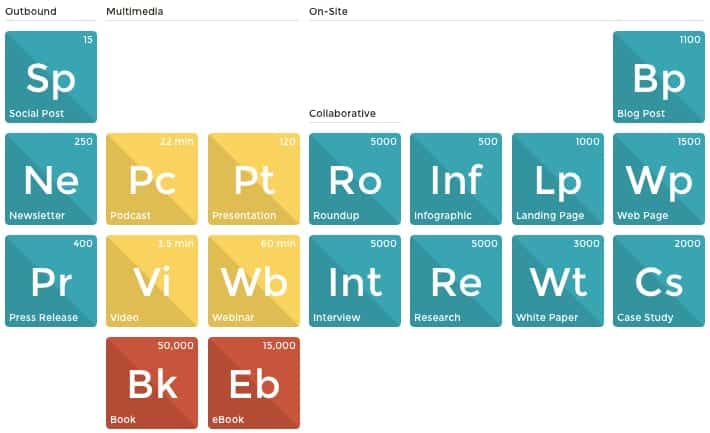
While several of these formats would fall under the category of written content, others such as video may not involve any writing at all. Other types of content might include a mixture of formats — for example a long-form article or case study that includes infographics and videos.
Here’s a drill-down into some of the more popular content formats today..
Content Hubs
Content Marketing Hubs, or “blog articles” are the most effective type of content marketing for bringing in early-stage, top-of-funnel traffic and web visitors. With simple question-and-answer style blog articles, thought leadership and authentic stories, you can become an authority in your industry.
So that when your audience is ready to buy, they think of you first. Blog articles are also great for SEO, fueling the hungry social media machines, and giving your website a “heartbeat,” as I like to say.
The best content marketing blogs come from real people, answering real questions from real customers. But before we get into all the fun visual, social and other varieties of content, it’s important to remember that in-depth text content is still preferred by most executives when making a decision.
Long-Form Content
If you’ve visited my site more than once you’ll probably have noticed that I’m pretty big on long-form content. It makes up the bulk of the content I create. I like it primarily because I love to write. I have a YouTube Channel and I’ve headed up a handful of video guides, but generally, you’ll find me putting pen to paper (not literally, but you get the analogy).
When I’m talking about long-form content, I mean text-based articles, consisting of 1500 words (give or take) and upwards. This is because longer articles have been shown to perform better in search results.
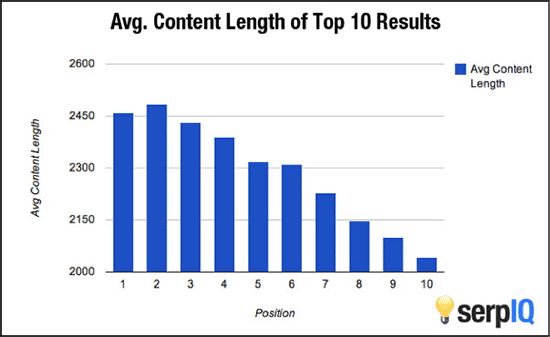
But I don’t just love long-form content because it performs well in the SERPs; I love long-form content because of how easily it can be shaped to diversify my traffic. Here’s how.
There are two key ways in which you can use long-form content to diversify your traffic:
- Diversify the topics you cover and the keywords you include. This helps you to mix up the search terms your site ranks for and diversifies how visitors find you and land on your site.
- Approach sites about publishing an article you’ve written. This gives you a quick route to access a new, readily-engaged audience.
When choosing topics to write about, don’t rely on your own ideas. I’m a big fan of Quora, Answer the Public, and Ubersuggest. These are all tools that can help you pinpoint what questions people are asking online, so you can craft content geared around answering them.
The more you mix up the topics you cover, the more you will be able to diversify your traffic.
That said, you should be sure to retain a consistent, underlying theme to your content. For me, that’s marketing. There is no point in creating content that drives irrelevant traffic to your site. Those visitors won’t come back, and they certainly won’t convert.
You’ll also risk sullying your reputation if your content lacks consistency. It’s about finding a balance between relevancy and variety.
For example…
- Only writing about how to drive organic traffic to a website=too specific.
- Writing about anything to do with the internet=too broad.
- Writing about the various elements of marketing a website=just right.
Personally, I don’t worry too much about keywords. For this site, I aim to write around 3000 words per post. This level of detail should give Google enough information to understand the themes of the page without my needing to force in particular keywords. However, it’s worth bearing in mind the risks of keyword cannibalization – an issue which can occur if you write multiple posts that cover identical or near-identical topics.
That said, keyword tools can be really useful for identifying themes to include, even if you don’t work the exact keywords into the article.
Infographics
Ask enough people and it won’t be long before someone tells you that infographics are past their expiry date. Or worse, that infographics are dead.
I don’t agree.
I’m not big on infographics myself – as in, I don’t create them myself. But I do see the value in them.
I also understand that while the art of the infographic might not be “dead”, it’s certainly on the decline. “Infographic posting generally rose steadily from 2007 to 2012, where it peaked, and has begun to decline since then,” said Sarah Rapp, Community Manager at Behance. Does this mean you’re fighting a losing battle if you choose to invest in infographic design? Of course not.
Great infographics can and do still get results.
This infographic from New York Magazine details the sleeping habits of history’s greatest minds. It secured coverage in Fast Co. Design, Mental Floss, and io9, amongst others.
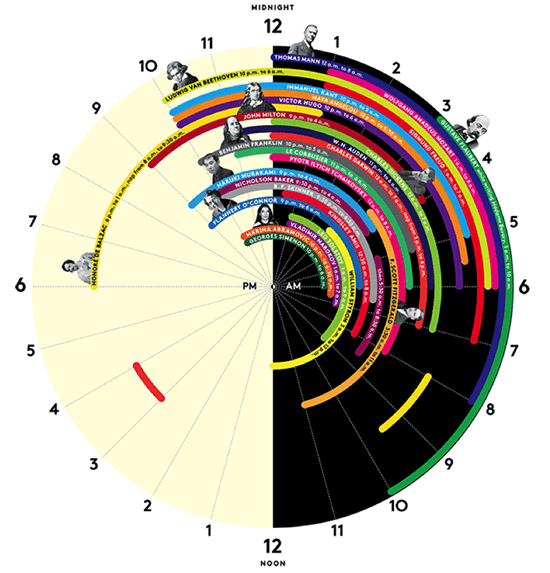
Daily Dot’s illustrated guide to dragons gained links from sites including Geekologie, The Huffington Post, Nerdist, and Joe.ie.
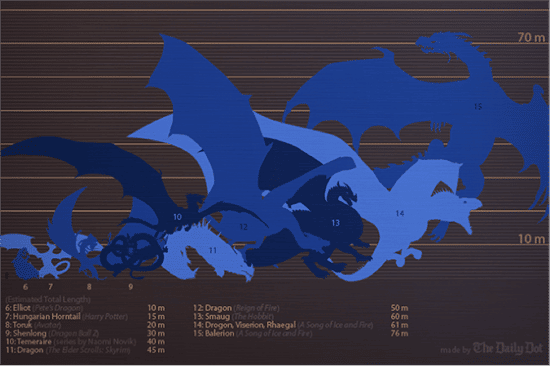
The fact is that a lot of high-authority websites are still keen to feature high-quality infographics, and their audiences are lapping them up.
Best of all, the format itself is diverse enough to be applied to pretty much any industry, and therefore target any audience. Infographics are also easy to republish, consume, and share, making the humble infographic an excellent tool for link building.
The key here is to diversify the subject matter of your infographics. Play it safe by sticking to the same topics and you’re going to limit the number and type of sites you can target and the audiences you can reach.
Be adventurous with the topics you cover and you should find yourself attracting visitors and links from all sorts of awesome sites.
Videos
Infographics are a highly diverse content format, but compared to video, they’re practically one-dimensional. Video embodies everything from six-second clips on a loop to brand adverts and feature length films. It can be used to inform, educate, inspire, shock, entertain, or persuade. There’s very little it can’t do.
It goes without saying that when it comes to video, YouTube offers access to the biggest and most diverse audience. It has over a billion users (that’s nearly a third of all internet users), while every day millions of hours of content is consumed via the site and its respective applications.
Of course, such a big audience means big competition. It comes with the territory. Understandably, this means standing out isn’t easy. You need be different, or better than everyone else. Or… very, very lucky.
So what makes a successful YouTube video?
According to Entrepreneur, the best YouTube videos tend to…
- Be short and to the point – three minutes or less is ideal.
- Illustrate the point of the video within its opening moments.
- Include a CTA early in the video, which is repeated throughout.
- Include the contact information of their creator.
- Have a specific goal or objective and are targeted to a very specific audience.
- Be unique.
- Be professionally produced and edited.
- Be easy to consume and understand.
- Include background music.
- Be in keeping with brand guidelines.
- Have a descriptive title – they don’t mislead the viewer.
Of course, there are exceptions to every rule. Take Nick Offerman’s Yule Log, a marketing video for Lagavulin whisky:
At just under 45 minutes it’s around 15 times longer than recommended. There’s no background music. No witty script. Or for that matter, any sound except the gentle crackling of a log fire.
The video has had more than 2 million views so far, an excellent response from viewers, and huge coverage in a multitude of publications. It’s different. It’s clever. And it works.
Of course, there is more to online video than YouTube.
Vimeo opens the doors to a smaller, but generally more engaged, audience than its big brother. YouTube attracts a lot of casual viewers – viewers that want simple, bite-sized entertainment.
Vimeo is a little more niche. Its users tend to be a tad more serious about the art of video production. It’s less “home videos” and “cat clips”, and more “art-house cinema”. It’s also ad free.
Its audience differs too. Fewer trolls, and more constructive feedback.
In fact, depending on the style and content of your videos, there’s little reason why you can’t target multiple audiences at once by uploading the same video to Facebook and Vimeo, and repurposing it into a Vine.
So how can you use videos to attract different audiences? As with infographics, one way to diversify the traffic your videos drive is to diversify their subject matter. However, I can see two potential roadblocks to this tactic…
- Many people that frequent video sites explore content, not just via the site’s search function, but by “following” producers that create content the viewer wants to see more of (YouTube, for example, is organized into “channels” that users can follow). This means that to build a regular, engaged audience, you generally need to create content of a similar type and style. The consequence of this is that it limits the audience you’re able to target.
- Producing and uploading videos to sites like YouTube means that any traffic, however diverse, gets driven to the respective video site, rather than your site.
Let’s take a look at some workarounds…
On YouTube, you can use “Playlists” to organize content according to “themes”. The primary purpose of Playlists is to allow viewers to watch a series of related videos without needing to keep pressing “play”. They’re also really useful for enabling your viewers to find the type of content that they enjoy most. This means you can diversify the subject matter of your videos without alienating or confusing viewers when covering inconsistent topics.
To see what I mean, take a look at the Vice YouTube channel. They have a huge library of videos. Sorting through it and finding videos of interest would be pretty taxing, if not for the Playlists section that enables viewers to narrow down the type of content they’re interested in watching.
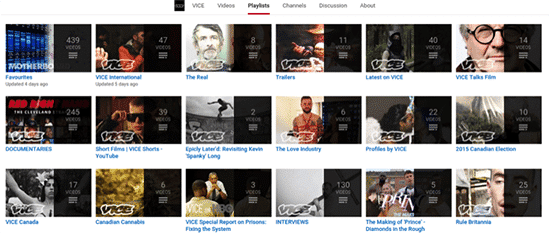
You can do something similar using Vimeo’s Channels.
The solution to getting people away from the video sites and to your website isn’t quite so straightforward.
It entails including convincing CTAs around and within your videos. You need to tell your viewers what you want them to do (visit a particular page of your site) and what’s in it for them. This means you need to offer your viewers something additional that they cannot get through your videos. Generally, this means a content upgrade.
Guest Posts
I know that “guest posting” as we once knew it (for the purpose of link building) is long gone — and that’s a good thing! But guest posting can still be a legitimate way of reaching new audiences, building your brand, and yes, gaining links.
I guest post regularly. I have regular spots on Forbes, Entrepreneur, and Inc, and have written a number of pieces for the Wall Street Journal.
The difference is that I’m picky about where and who I write for. I want my name to be attached to sites that my peers and potential customers respect. I want to be on sites that boast engaged audiences that are relevant to me and what I do.
How did I do this? I started small and worked my way up.
You’re unlikely to bag a regular spot on a big site unless you’ve already made a bit of a name for yourself. Target smaller, industry-specific sites at first. Work on developing an engaged Twitter following. Build your connections and endorsements on LinkedIn.
Personally, I began by targeting sites like Search Engine Journal, Social Media Today, and Mention. Publications at this level are much more open to contributions from “unknowns”, but it helps to approach them with the right topics, or better yet, a finished piece. In my experience, these kinds of mid-tier sites are as interested in the subject matter and quality of the content as they are in the person behind that content. You generally won’t get very far with a speculative “Hey, I’d love to write for you” kind of email. Be up front about exactly what you can offer them.
When you’ve got a bit of credibility and a handful (you really only need a handful) of quality, successful posts that you can include in your resume, the really big publications are far more likely to sit up and listen to what you have to say.
This is because (again, in my experience) the big, big sites are just as interested in who you are as in the topics you’re writing about. Why else would it be so important to build some credibility before approaching them? They want you to bring the full package to the table. Consequently, I’ve found that pushing my credentials, not an article topic, works better when trying to get my foot in the door of these big-name sites.
Interviews
I love interviewing other people, and I love it when people interview me.
I also think that interviews are an excellent device for tapping into a new audience – namely, the audience of the person you interview, or that interviews you.
This strategy essentially comes down to getting other people involved in your content. You can actually do this without having to go to the extremes of carrying out a full interview; securing quotes from influencers can have a similar effect. However, I’ve found I get the best results if I go whole hog and take the time to interview someone properly (or have them interview me).
Why?
Two reasons:
- The more involved someone is in the creation of a piece of content, the more invested they will be in its success. Someone who’s provided a quick quote for you might tweet the finished article, but in my experience, they’re unlikely to do much else. Someone who’s spent half an hour answering your questions will probably share the resulting content across multiple social channels (potentially, multiple times) and might even link to it from their site.
- Taking the time to talk to someone properly – to ask them questions and listen carefully to their answers – can help you to build a real, genuine relationship with that person. This can have benefits that reach far beyond that initial piece of content. It’s not what you know, after all…. (Disclaimer: it kind of is what you know, but who you know definitely helps, too!)

Podcasts
Thinking about making the leap from article writing to something a little more hands-on, but aren’t quite ready to speak on screen? Enter: podcasting.
First coined in a 2004 article by Ben Hammersly, podcasting has seen year-on-year growth pretty much every year since.
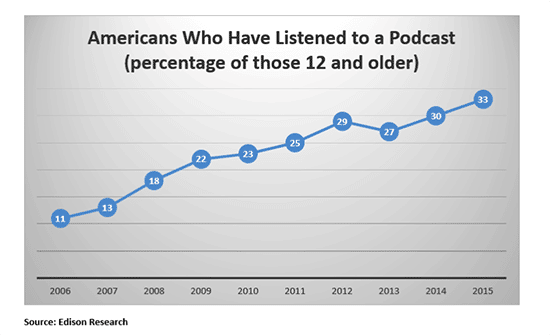
Podcasts are popular primarily because they allow us to consume content while we’re on the go. Unlike videos or articles, which demand most, if not all, of our attention, we’re able to listen to podcasts pretty much anytime, anywhere. They’re an easy and convenient way to consume new content and information.
Okay, so the audience numbers will pale in comparison to what you could potentially access on YouTube. But that’s fine. There’s also less competition.
In my experience, podcasters tend to be pretty open to guest speakers, too. Get your name out there and reach new audiences by interacting with established podcasters in your industry and nabbing yourself a guest spot on their show.
Later down the line, start inviting other people to speak on your show.
Bear in mind however, that (like with YouTube and other video sites) unless you’re hosting a podcast on your own site, you’re not going to be driving traffic directly to it. Your way around this is to encourage listeners to visit your site by placing CTAs throughout the podcast. Tell them where you want them to go, why, and what they’re going to get out of it.
What Types of Content Should You Create?
Each type of content has its own pros and cons. For example, while video can be highly engaging and shareable, it can be time-consuming and expensive to create. There are various points you need to consider before deciding on content formats for each of your content marketing campaigns. These include:
- Your intended audience (do they like to read articles or watch videos, for example?)
- The type of information you want to include (stats and figures usually work best as a chart or infographic, while “how to” type content might be easier to follow as a video rather than written instructions)
- Your budget and time commitments
- Do you have the skills and equipment in-house for the type of content you want to produce, or would you have to outsource?
Most businesses will get the best results from mixing things up and producing content in several different formats. Experimenting in this way not only keeps your audience interested but it also enables you to figure out the type of content that converts well.
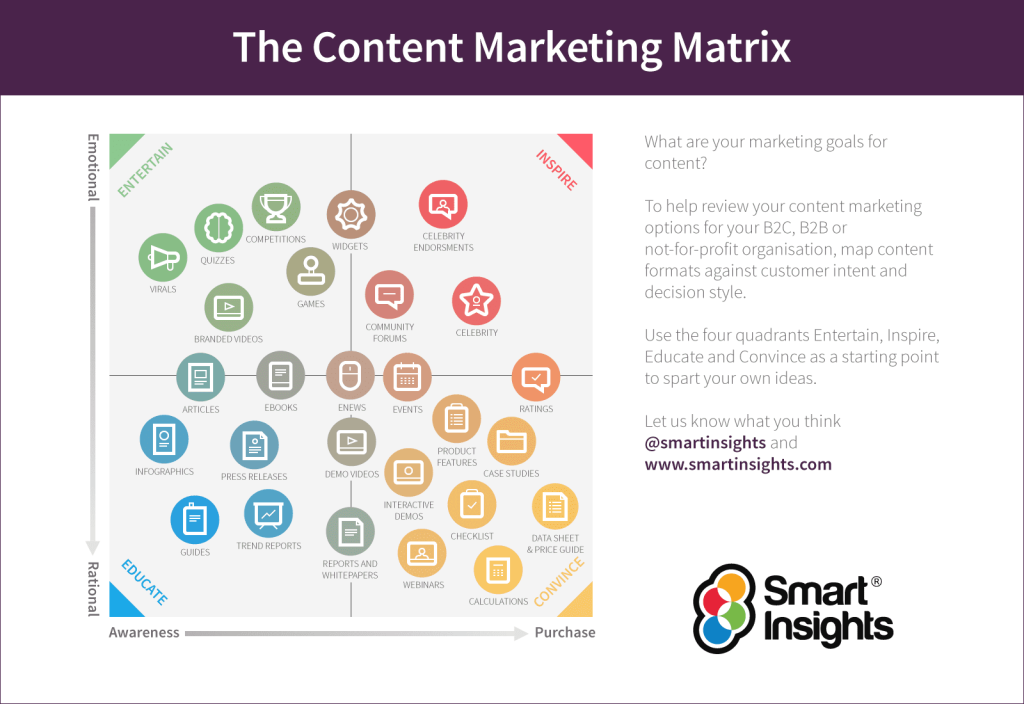
The sheer number of options in content marketing can be overwhelming, particularly if you have limited resources or a tight budget. So how should you decide which formats to choose for your content marketing strategy?
The answer is, it depends on your buyer. But the fact is that variety is one of the keys (along with volume and value) to an effective content marketing strategy in any industry.
Repurposing your content into several different formats is also an effective way to squeeze more ROI out of every piece of content and reach a wider audience. For example, one blog post could also be re-created as a podcast, video, and potentially an infographic. If you’re relying on one type of content you’re going to struggle to attract more than one type of visitor, or to get featured on more than one type of site.
Why should you be worried about this? Two reasons:
- The number of customers you reach, and consequently the growth of your company and brand, will be limited.
- The value of new links will be diminished (if a site has linked to you once, any subsequent links from that same site will have diminishing returns – you need to target links from new domains in order to keep building your own site’s authority).
I like to show these content formats by buyer stage in this full content marketing strategy visualized:
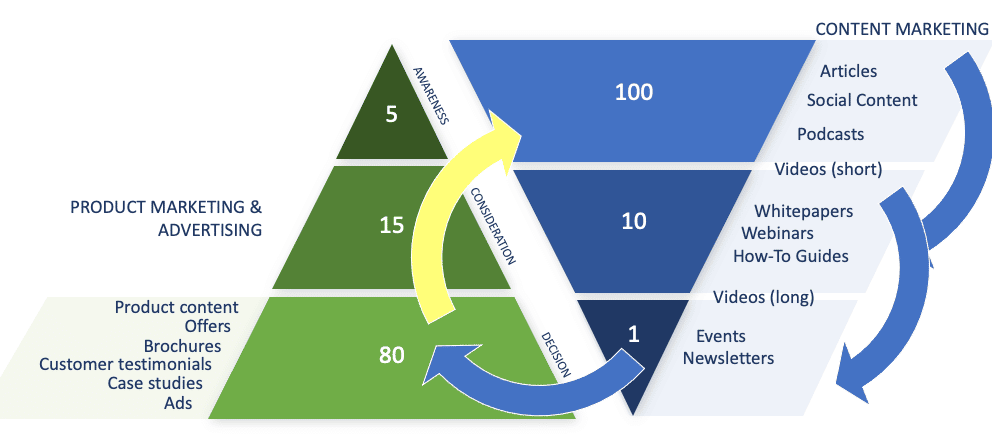
You should closely monitor the best content marketing examples from your industry from where you can get ideas and insights to diversify the traffic you attract.
How to Choose the Right Content Format for Your Audience
Many businesses find that creating content that’s relevant for their audience is one of their biggest challenges in content marketing.
For your content to be effective it’s vital that you not only choose topics that will resonate with your audience, but also that you publish content in a format that has the best chance of being consumed and shared.

The key to getting this right is to carry out in-depth research on your audience. When you really understand the preferences and motivations of your audience, as well as their online habits, you can come up with a content plan that is optimized for success with your particular audience.
Start by reviewing your analytics software and other audience intelligence. Identify segmented groups to target each of your content marketing campaigns with. You should consider:
- The age and demographics of your audience. If you’re marketing mainly at Millennials, short-form video is probably a good format choice, while older demographics tend to prefer long-form text.
- What content formats are they engaging with?
- What are they sharing?
- Where are they spending their time online?
- What are their preferred social networks? (a content strategy for an audience that’s mainly on Snapchat would look very different to one for an audience on LinkedIn)
- Think about the goals of each piece of content too – for lead generation, content such as ebooks, whitepapers, and webinars is more effective than standard videos or blog posts. Content that actually leads to conversions might look very different from content that is shared a lot on social media.
While you should be guided by your initial research, it’s important to experiment and test to optimize your content plan. While the stats might say that Millennials prefer short-form video, the Millennials in your audience might engage more with ebooks or podcasts.
Pros and Cons of Popular Content Formats
When you’re deciding which formats to use in each of your content campaigns, it’s important to take a balanced view and consider what’s possible and realistic for you to create, what you’d publish with unlimited budget and resources, as well as your goal of turning visitors into customers.
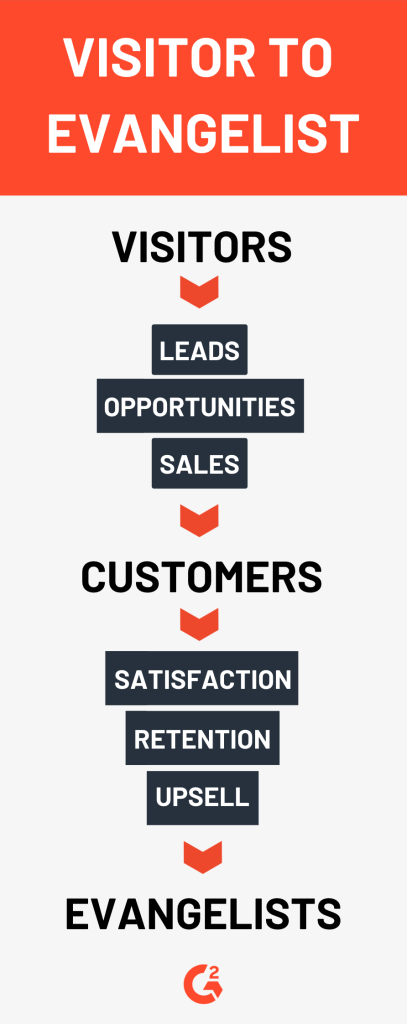
Image Source: G2
Blog Posts
- Relatively cheap and easy to produce
- Effective at boosting SEO
- Must be published on a regular schedule for best effectiveness
- Highly flexible – can be short or long-form and can be effective for many different goals including to add value to your existing customers, convert new leads into customers, or to build brand awareness
- Attracts comments and guest posts
Video
- Video is one of the most engaging forms of online content and its popularity is continuing to increase
- More difficult and expensive to produce than text content, although it is definitely possible to produce simple videos on a small budget
- Time-consuming and resource intensive
- It can be difficult to produce videos that are truly engaging
- YouTube is the world’s second largest search engine and shows over one billion hours of video every day to its users
- Some of the most shared content on social media is video
- Highly effective for branding and boosting authority
Podcasts
- Effective at building audience relationships and loyalty
- Opportunity to connect with a captive audience
- Podcasts are a growing trend – over 30% of the US population listens to a podcast at least once a month
- Higher barrier to entry – equipment for recording high-quality sound is essential
- Consistent production is essential to maintain an audience
- Difficult to measure ROI
Infographics
- Great for representing data in an easy-to-understand format
- Popular content format for sharing on social media
- Other blogs likely to use and link back to your site – great for brand awareness and SEO
- Only suitable for specific topics
- Collecting data and producing graphics can be time-consuming
- Low engagement potential.
What’s Your Competition Doing?
When you’re in the early stages of your content marketing plan, look to your competitors and figure out what they’re doing and what is getting the most traction (as most people now very considerately publish how many shares and likes they get on their content that’s relatively easy to figure out).
As long as you take into consideration the quality of the material, you’ll be in a great position to figure out what kind of format you should pursue. Is it mainly text-based or are they using some amazing visuals?
Though obviously you’re not planning to copy what they’re doing directly – as then there is no way to differentiate your own brand from theirs, besides how can you beat them if you’re the same? – copying what they’re doing in terms of formatting wholesale is an entirely different matter.
Content Marketing Analytics
Google Analytics will give you a good idea of what content and format on your site is doing exceptionally well. Note, that here you’re not just interested in overall viewing numbers, as that doesn’t allow you to disentangle the quality of your post from the format you presented it in.
To do that, make sure you look which format has more legs (as in keeps drawing an audience for the longest), how long they spent on the different pages, and the bounce rate, as each of these can give you some kind of clue as to what people like. Longer legged content is obviously more interesting to your audience while a high bounce rate is indicative that they might not like this format as much as you might have hoped.
Also, be sure to aggregating over different posts by grouping different formats as well as different posts types together and comparing these against each other. This will then give you rough estimates of what is doing better.
With that information, you can then
Reformat Posts That Do Well
If you presented information in one post that did exceptionally well, don’t be afraid to repurpose it and present it in a different format. This will work even better if you happen to have slightly updated information.
In this way you’ll be in a much better position to separate content from format, as the content is similar (even if rehashed) and therefore the difference is more likely down to the format. So if you see a slight drop in interest, it’s probably down to repetition, while if you see an increase in interest in the second post, then that format suits your audience exceptionally well.
So, for example, if you had a good blog post that attracted a lot of attention, consider creating a infograph and presenting that. Alternatively, if you’ve presented a lot of statistics or images, consider presenting it in a slide deck.
Repurposing your data in this way will allow you to explore whether a different format works better for your audience, while also allowing you to repurpose old content and keep it coming back (thereby having more time to create killer new content).
The good old two birds with one stone situation.
Experiment, Observe, Ask
From there can try out presenting new posts in the format that has done well to see if the first time was a fluke or if the pattern holds, while all the while making certain that you track the data in google analytics religiously.
As noise has a tendency to cancel itself out over time, the more different posts you have in different formats, the more likely it becomes that the difference in visitor numbers between the different format types are down to the actual format type.
Also, don’t be afraid to ask people how much they liked a post. If you ask them to give you a 5-star rating at the end of an article (tell them feedback is the key to perfect content as then you can understand what they want) and you’ll get a good idea of what works and what doesn’t. Besides, people like it when websites they visit regularly ask them for their opinion, so it might even make it more likely that they’ll come back.
And that’s a nice little bonus, don’t you think?
Diversify Your Presence
Get your brand messaging and content in as many relevant places as possible. This might mean creating long-form content that ranks in the search results for a multitude of relevant terms. It probably also means becoming an influencer on a social media channel or two for your niche.
There’s no set rule that dictate what kinds of content to create – the trick is simply to mix up what you do: be adventurous with the content you create and the people and publications you approach about it.
Have you tried your hand at a new form of content with the aim of reaching a new audience? Please take a minute to let me know what you did and the results you saw in the comments below!
If you are ready to get more traffic to your site with quality content that’s consistently published, check out our Content Builder Service. Set up a quick consultation, and I’ll send you a free PDF version of my books!







I generally like your content, Michael, but am surprised you think graphs dated 2015 reflect current tactics. Surely you could source more recent data?